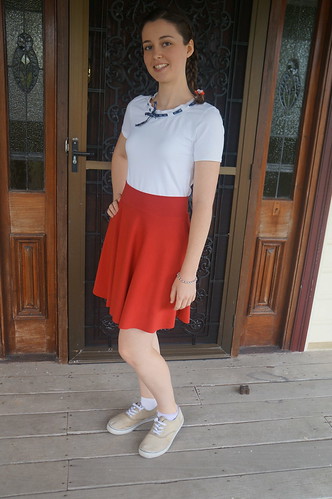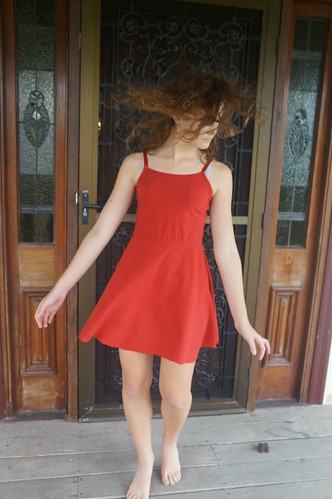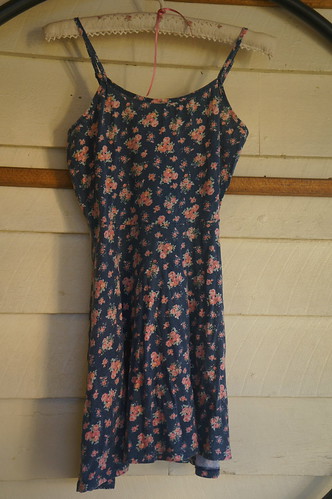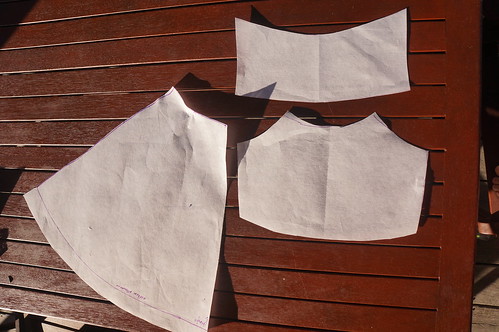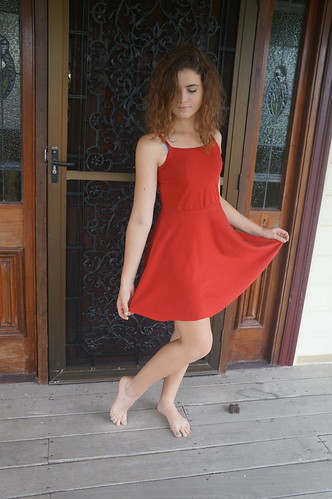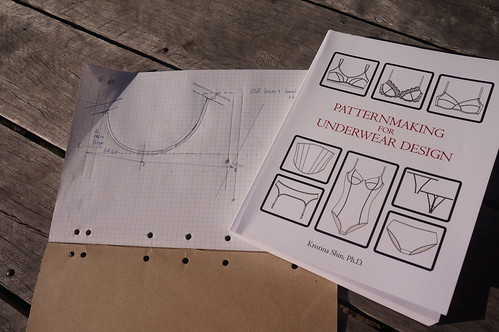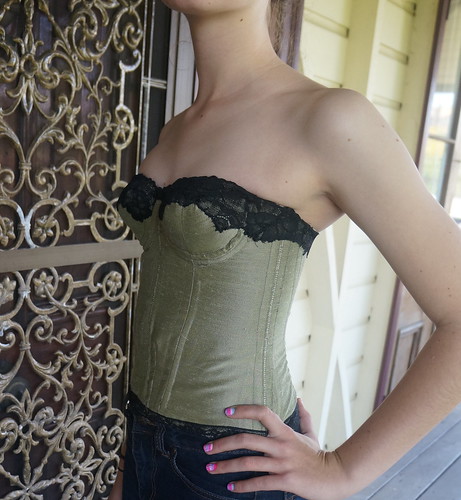I told you about the rejected skirt-front-with-a-seam in it from the last project, and after whinging about the wastefulness in the last post, it was clearly incumbent of me to use this left over fabric piece in a responsible manner - and straight away, as layer 4 of my stash is rather too large.
Fortunately, I have sewing blogs for inspiration. I fancied the easy wearing reputation of this skirt by Sewing Sveta.
I cut out another half skirt, a yoga waistband (well, actually I used the waistband from Jalie 2796, having just made a few of these and knowing the waistband fit perfectly), and ended up very quickly with this skirt for my older daughter.
The back centre seam is stabilized with woven cotton selvage.
There is not much else to say about it, except that it also helped with the offspring sewing balance levels.
Stashbusting statistics, another metre of that cotton lycra knit from Stretchtex in a loud colour for the April theme- only a teensy bit late in posting...
I am joining MeMadeMay this year too, in order to encourage myself to sew more clothes for work. I have exactly 4 blouses and 3 pairs of trousers for this purpose, and as I work full time, this is very hard on the laundry! I might post photos once a week - and change out of my grubby gardening clothes before I take a photo today......
Showing posts with label self drafted pattern. Show all posts
Showing posts with label self drafted pattern. Show all posts
Saturday, 2 May 2015
Friday, 1 May 2015
The dangers of disposible fashion, not seriously
I sew. It would seem fairly obvious that disposable fashion is not my cup of tea, and I could provide all sorts of morally superior reasons for this opinion in order to impress the sewing community with my ethical standards and awareness of global issues, but a large part of my abhorrence of these garments is much more trivial. They are aesthetically displeasing and wasteful of one's clothing budget.
My teenage daughter went to the beach for a week with her friends. They had a terrific time, and she came back with a $5 dress she had bought.
She usually has very good taste in clothing, I am sure that when she bought this little knit sundress, it was quite pretty. By the time I saw it though, it had been worn over a swimming costume for several trips to the beach, and had been washed. The print was faded, the fabric was pilled, the hem was grossly uneven, making it scandalously short in inappropriate places, the bodice draped in an underwear/swimming costume displaying manner, and the entire garment was about 2 sizes too big. (1 week of use)
The dress was, according to my standards, unwearable. I expressed this opinion, originally with some attempt at tactfulness, but as she continued to wear it - even out of the house! the expression of my opinion became increasingly forthright. To my undisguised horror, she even threatened to take the dress to Brisbane with her and wear it to University, where at least I would not have to look at it. This may have been a cunning, deeply laid plan on my daughter's part. What can a mother do about her daughter's clothing choices? I know I rarely took any notice of my mother's opinion of my clothing when I was 17 (or at least I pretended not to take any notice)
Eventually, we came to a compromise. She would agree to dispose of the dress (the rag bag was looking good), if I would make her a replacement dress. Hence my suspicions about my daughter's possible mother manipulation tactics.
It was ridiculously easy.
I traced off the stretched out, horrible gappy bodice, trimmed about 3 cm from each side of my pattern piece, added 3 cm to the length of the bodice in order to diminish underwear exposure, and traced off one section of the skirt, correcting the grain and hem, and adding more length than I was later permitted to use. This may have been a cunning daughter manipulation technique to ensure later sufficient length to the skirt. Despite the long sentence, this took about 10 minutes.
The construction and cutting out of the dress took at least 30 minutes. This was only because the first version of the dress had a seam down the front, and this was rejected in my version, the solid fabric (cotton lycra from Stretchtex) not disguising this sufficiently. I had to chop the skirt off, cut off the side seams and replace the front with a single piece.
The top of the bodice is bound with the same knit, and the straps are lingerie straps which I serendipitously had lying around in the same colour as the knit. I reinforced the waist seam with lingerie elastic to improve stability and to support the weight of the skirt.
I then insisted that the dress hang (by the waistline) for a week before I hemmed the dress, except that I didn't hem the dress, I just cut the hemline to an even length.
The dress was received with qualified approval (another 2 inches off the hemline, and some discussion about the next one having deeper armscyes)(did you hear that next one remark), and I was allowed to chop up the beach dress. It was very satisfying.
I didn't do my own sewing,and I am seriously low in the boring-blouse-for-work department. That was the locally dangerous bit about the disposable fashion
I paid a token to my environmental consciousness by cleaning the bathroom with my new rags and a biodegradable septic safe cleaning potion. It doesn't have any real effect, but I'm sure it made me feel better.
Stashbusting statistics, about 1.5 m cotton lycra knit, in a nice bright colour for the Stashbusting challenge
Friday, 5 September 2014
Project formal, the foundation. Burda Style 01-2014 113 + Patternmaking for Underwear Design
I've made a couple of formal dresses before, but somehow, this is turning into one of my most technically challenging projects. Most of this is self inflicted! Some of my blogging absence has been due to a lot of unblogworthy thinking and planning time. (The rest was knitting.....)
Most strapless dresses need a foundation to prevent wearing malfunctions. For my older daughter's formal dress, also strapless, I made a traditional princess line bodice foundation, based on Claire Shaeffer's somewhat scanty instructions in Couture Sewing Techniques, and was happy with it. However, daughter the second has a more curvaceous figure, and more exacting requirements, and wanted more shape and structure in the bust of her foundation to emphasise the sweetheart neckline of her dress. She wanted something more like a long line bra or corselet.
Unfortunately, the bust section of the Burda bustier toile I made earlier was not at all flattering, nor supportive. I decided to add bra like cups and bridge to the bustier, for more structure,and went looking for either my Kwik Sew bra pattern, or my Leanne Burgess bra making book. 2 days later, my pattern collection and fabric cupboard were unaturally tidy, and I was forced to realise that I had carefully put all my lingerie sewing references in a Safe Place, from where they would only emerge again when they were not immediately required.
My long suffering family (one of whom suggested that I buy a corset!) was greatly relieved that I was rescued by Kristina Shin's Patternmaking for Underwear Design, a book that has been lurking on my sewing shelf since Christmas, after my inital perusal filled me with disappointment. I had bought it with the intention of drafting myself a bra pattern, but the only bra drafting instructions in the book are for a 75B, which fits no one in our house, and the measurements for each drafted line are given within the instructions, with no tables for any other sizes, making the usefullness of the bra instructions quite limited - but we decided to increase the cup size of the foundation for illusionary purposes, and decided the given cup size of 75B would do for the size 34-taken in bustier, with a bit of discreet curve enhancement.
I drafted a 3 part T cup underwire bra cup and bridge, following the instructions without undue difficulty (although having 2 unlabeled markings that were only identifiable by reading two separate earlier chapters of the book was annoying, as was the tendency to constantly refer back to the basic bra block- which uses the same letters as point markers as the 3 part cup, only in completely different places!).
I used foam bra lining (cut out and pieced to fit from an existing bra, and added a small "fillet" made from 2 layers of cotton/wool quilting batting to the lower third of each cup. The "pad" or "cookie" shape given in Shin's book was not the correct size nor shape for the cups, so this was again made by trial and error.
As the upper cup was still too large, and we did not want excessive padding, I applied 3 rows of shirring elastic by this method through the outer cup fabric and foam lining at the top of each cup and gathered these to fit. Although producing the desired effect, this looked rather messy, so I lined the corset with a rayon knit (I draped this over the finished outer corselet and cut to fit - much easier than applying all the fitting changes from the woven outer pieces to a woven lining)
The entire upper border of the corselet is finished with slightly stretched lingerie elastic for added security. I hand appliqued a stretch lace to the upper cups to cover the shirring (this is practice for the actual dress), and also to most of the upper border of the remaining corselet because it looked pretty.
The remainder of the construction was much more straightforward. Each vertical seam is boned with rigeline on both sides of the seam. The outer fabric is a firm weave silk (from my grandmother's silk painting supplies), and the underlining is silk organza. The boning casing is herringbone weave linen.
As it is still 9 weeks to the wearing of the dress, I wanted to allow some room for girth changes. so I used a commercial elastic fastening (Prym) instead of the right centre back section . As you can see, I actually used two of these, as the fastening is designed for a long line bra. The two fastenings are abutted, joined with zigzag stitch, and a ribbon applied over the seam for prettiness (she doesn't need the stretch at the waist). I chose to fit at the wider of the two hook and eye loops as my daughter tends to lose weight when under stress, and is currently finishing her final year at school, with constant assignments and exams. If the opposite occurs, well there is a bit of stretch in the elastic ;).
The lower border of the corset is zigzagged to attach all the layers, then non stretch lace was applied to cover the zigzagging. I did not want to add bulk with a hem or binding.
The finished foundation met with approval, and I am well into the next stage of the dress.
Most strapless dresses need a foundation to prevent wearing malfunctions. For my older daughter's formal dress, also strapless, I made a traditional princess line bodice foundation, based on Claire Shaeffer's somewhat scanty instructions in Couture Sewing Techniques, and was happy with it. However, daughter the second has a more curvaceous figure, and more exacting requirements, and wanted more shape and structure in the bust of her foundation to emphasise the sweetheart neckline of her dress. She wanted something more like a long line bra or corselet.
Unfortunately, the bust section of the Burda bustier toile I made earlier was not at all flattering, nor supportive. I decided to add bra like cups and bridge to the bustier, for more structure,and went looking for either my Kwik Sew bra pattern, or my Leanne Burgess bra making book. 2 days later, my pattern collection and fabric cupboard were unaturally tidy, and I was forced to realise that I had carefully put all my lingerie sewing references in a Safe Place, from where they would only emerge again when they were not immediately required.
My long suffering family (one of whom suggested that I buy a corset!) was greatly relieved that I was rescued by Kristina Shin's Patternmaking for Underwear Design, a book that has been lurking on my sewing shelf since Christmas, after my inital perusal filled me with disappointment. I had bought it with the intention of drafting myself a bra pattern, but the only bra drafting instructions in the book are for a 75B, which fits no one in our house, and the measurements for each drafted line are given within the instructions, with no tables for any other sizes, making the usefullness of the bra instructions quite limited - but we decided to increase the cup size of the foundation for illusionary purposes, and decided the given cup size of 75B would do for the size 34-taken in bustier, with a bit of discreet curve enhancement.
I drafted a 3 part T cup underwire bra cup and bridge, following the instructions without undue difficulty (although having 2 unlabeled markings that were only identifiable by reading two separate earlier chapters of the book was annoying, as was the tendency to constantly refer back to the basic bra block- which uses the same letters as point markers as the 3 part cup, only in completely different places!).
This was not quite the shape we wanted, so I then rotated and split the lower cup and drafted an upper cup to fit a slightly higher bridge and not require a strap - a shape that is not given in Shin's book.
The cup was larger than expected, despite being cut out in a woven rather than a knit, as assumed in the instructions. This could have been operator error and was fixed with a bit of trial and error trimming. Fortunately I do not plan to make a lot of these garments in the illusionary size.I used foam bra lining (cut out and pieced to fit from an existing bra, and added a small "fillet" made from 2 layers of cotton/wool quilting batting to the lower third of each cup. The "pad" or "cookie" shape given in Shin's book was not the correct size nor shape for the cups, so this was again made by trial and error.
As the upper cup was still too large, and we did not want excessive padding, I applied 3 rows of shirring elastic by this method through the outer cup fabric and foam lining at the top of each cup and gathered these to fit. Although producing the desired effect, this looked rather messy, so I lined the corset with a rayon knit (I draped this over the finished outer corselet and cut to fit - much easier than applying all the fitting changes from the woven outer pieces to a woven lining)
The entire upper border of the corselet is finished with slightly stretched lingerie elastic for added security. I hand appliqued a stretch lace to the upper cups to cover the shirring (this is practice for the actual dress), and also to most of the upper border of the remaining corselet because it looked pretty.
The remainder of the construction was much more straightforward. Each vertical seam is boned with rigeline on both sides of the seam. The outer fabric is a firm weave silk (from my grandmother's silk painting supplies), and the underlining is silk organza. The boning casing is herringbone weave linen.
As it is still 9 weeks to the wearing of the dress, I wanted to allow some room for girth changes. so I used a commercial elastic fastening (Prym) instead of the right centre back section . As you can see, I actually used two of these, as the fastening is designed for a long line bra. The two fastenings are abutted, joined with zigzag stitch, and a ribbon applied over the seam for prettiness (she doesn't need the stretch at the waist). I chose to fit at the wider of the two hook and eye loops as my daughter tends to lose weight when under stress, and is currently finishing her final year at school, with constant assignments and exams. If the opposite occurs, well there is a bit of stretch in the elastic ;).
The lower border of the corset is zigzagged to attach all the layers, then non stretch lace was applied to cover the zigzagging. I did not want to add bulk with a hem or binding.
The finished foundation met with approval, and I am well into the next stage of the dress.
Thursday, 27 September 2012
Pleated skirt, lucky last work wardrobe piece

I like to think that sewing allows me to indulge my creative side, but clearly my creative side is completely subject to my goal setting side.
Having mentally planned a 2 skirt work wardrobe for my daughter, I was unable to let it rest once she had finished work experience, and had to make the second skirt to soothe myself and allow me to move on to anther project. I dare say she will need some work clothes in the future!
My plan for this skirt was inspired by some very cute skirts that my older daughter had tried out in Cue, for which we had bought very expensive jacquard denim in which to try replicating the shape of the skirt. (I notice that there are no skirts with this pleating on the website anymore). I wanted to try this non-pattern sewing out prior to the denim.
My daughter and I auditioned 4 different bottom weight fabrics from the stockpile. I had about 5 yards of cotton twill in grey/green cross woven with deep charcol from Michael's Fabrics - This is from a $7 per yard bundle (+ postage works out to about another $5 per yard), but I suspect it is far more luxurious than the $40 per metre denim as the hand and drape is so beautiful. The twill looks terrific with 3 of the 4 blouse fabrics, and the reverse side of the bolero jacket, leaving us both feeling very clever at our wardrobe building skills.
The skirt is simply constructed - in theory.
I took 2 x a full width of the twill (about 150cm) and sewed the short ends together making an in inseam pocket on the way.

I then cut the back piece in half, inserted a lapped zipper and started draping.
The front and back are first pleated so that 1/2 of the front (or back) waist measurement is brought to meet at each centre front (or back). The remaining outer layer of fabric is then reverse box pleated to fit this measurement, with the pleats meeting at approximately half way between the side and the centre of the front and the back.

This makes the skirt extremely full, with double pleating, making the waist look tiny, particularly when it starts out as the waist of a fit 15 year old with an hourglass figure.
In practice, the tweaking of the pleat positions for a flattering position and to sit smoothly over the derriere and hips took several attemps and a lot of pins. In retrospect, using the full width of the fabric was a mistake, as the inner pleats are too large, extending past the side seams at the back, which made fitting more difficult, although we are happy with the skirt now that it is finished. For my daughter's dimensions, I should have used less width. (The Cue fabric must have been more narrow - as I saw the selvage in the seams during close inspection after my older daughter tried it on)
The waistband is a straight strip, interfaced, and buttoned at the centre back.

You can see here that I overlapped the back outer centre pleats due to the excess fabric.
The hem is machine blind stitch, and seems to show very clearly in the photographs where in real life it is not noticeable. Weird. The fabric has a very slight sheen, so maybe this is the reason?
Having rather a lot of the fabric left, I was considering a pair of trousers to fill out the wardrobe, but fortunately, have no burning urge to sew these in the immediate future. Phew!


Here is the full wardrobe I have sewn for my daughter - she has a RTW black straight skirt to pad this out.

Here is the 5 piece wardrobe I am entering in the Pattern Review mini wardrobe challenge.
Thursday, 17 November 2011
Get that fabric out of here, a couple of very quick projects in knit
There are many approaches to stash management. Long ago, I decided that fabric that one does not exactly like seems to multiply in the depths of the stash until you open the fabric cupboard, carefully holding back the overflowing top shelf, and realise with dismay that there is nothing to sew in there.
I am improving my stash management.
Only a few weeks ago I received an internet order containing disappointing thin, minimal recovery knits. One went out straight away as a trial version of a knit pattern, but the other was a lot more fun. I used it for sewing experimentation.

(Please note the garden hose in the photo, almost as good as a rubbish bin - photo taken before school in a big rush, we have quality pictures here)
I made this last night after dinner. It is inspired by a RTW knit skirt.
I did not draw a pattern, as I was just playing around.
I cut out a semi circle,with the stripes parallel to the diametre, then marked two points equidistant from the centre, each half of the waist width, then cut the sides at a pleasing to the eye angle from the outer waist mark to the bottom edge of the skirt. I folded the skirt in half to check symmetry, trimmed a bit, then cut the waist edge to a slight concave curve. I did not take photos because they would have been lousy, taken- inside dark ones.

The waist is two layers of the knit, cut so that the stripes on the inside match up with the stripes on the outside, as the colours show through the white spaces otherwise.
Construction was
1 Sew skirt seams together - matching chevrons was the only part requiring a little care.
2 Sew short edge of waist pieces together
3 Sew waist piece to waist edge of skirt, stretching to fit (about 5% difference in measurement)
4. Cut strip of elastic to 2cm less than waist measurement, sew short ends together
5. Sew elastic to top edge of waist, right side, then turn elastic over to wrong side, turn waist edge over again and topstitch using 3 step zig zag.
6. Hem skirt.
My daughter is very pleased with her new skirt, and I do not really care that the fabric is likely to wear out after only a few washings, as my time investment in this project was very small.
Unfortunately, there was a garment sized piece of fabric left over. I struggled with this wastefulness on the way to the bin, and my tightwad nature won.
I made a tank top with fold over elastic trim for my older daughter to wear as loungewear/pjs.

It looks better in the photo than in real life.
I guess that was the problem with the fabric in the first place!
Hopefully that will help prevent the ugly fabric multiplication disease in the collection.
I am improving my stash management.
Only a few weeks ago I received an internet order containing disappointing thin, minimal recovery knits. One went out straight away as a trial version of a knit pattern, but the other was a lot more fun. I used it for sewing experimentation.

(Please note the garden hose in the photo, almost as good as a rubbish bin - photo taken before school in a big rush, we have quality pictures here)
I made this last night after dinner. It is inspired by a RTW knit skirt.
I did not draw a pattern, as I was just playing around.
I cut out a semi circle,with the stripes parallel to the diametre, then marked two points equidistant from the centre, each half of the waist width, then cut the sides at a pleasing to the eye angle from the outer waist mark to the bottom edge of the skirt. I folded the skirt in half to check symmetry, trimmed a bit, then cut the waist edge to a slight concave curve. I did not take photos because they would have been lousy, taken- inside dark ones.

The waist is two layers of the knit, cut so that the stripes on the inside match up with the stripes on the outside, as the colours show through the white spaces otherwise.
Construction was
1 Sew skirt seams together - matching chevrons was the only part requiring a little care.
2 Sew short edge of waist pieces together
3 Sew waist piece to waist edge of skirt, stretching to fit (about 5% difference in measurement)
4. Cut strip of elastic to 2cm less than waist measurement, sew short ends together
5. Sew elastic to top edge of waist, right side, then turn elastic over to wrong side, turn waist edge over again and topstitch using 3 step zig zag.
6. Hem skirt.
My daughter is very pleased with her new skirt, and I do not really care that the fabric is likely to wear out after only a few washings, as my time investment in this project was very small.
Unfortunately, there was a garment sized piece of fabric left over. I struggled with this wastefulness on the way to the bin, and my tightwad nature won.
I made a tank top with fold over elastic trim for my older daughter to wear as loungewear/pjs.

It looks better in the photo than in real life.
I guess that was the problem with the fabric in the first place!
Hopefully that will help prevent the ugly fabric multiplication disease in the collection.
Subscribe to:
Posts (Atom)


